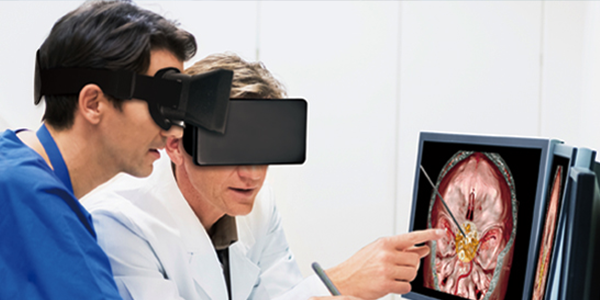
We all know that VR and AR have had an everlasting impact in the global world and what’s next is, that it’ll continue to have with several innovations taking birth in tune with the emerging trends. Needless to say, many tech giants and even startups are investing in the augmented reality and virtual reality to offer a real experience to the customers in the virtual world. The prominent questions that hover in one’s head are what is the scope of augmented reality (AR), virtual reality (VR) and mixed reality (MR) in pharma and healthcare sectors? How is that going to benefit the healthcare sector and the pharma companies? The answer is straight and simple. With the introduction of faster and smarter technology, pharma and healthcare were among those diverse sectors that have progressed fast. Augmented reality and virtual reality are gaining prominence among medical personnel for various applications that offer improvisation of equipment maintenance, patient care, surgical training, and rehabilitation.
For many years, healthcare industry and pharmaceutical companies have been formulating ways in this digital world as in how to best serve the needs of their customers who are patients, doctors, nurses, hospital administration, etc. Their struggle to achieve one includes maintaining stringent specifications on their marketing messages while delivering the promising results and also increasing sales. Considering the fact that the present age that we live in is a digital era, one should not be carried away presuming that Virtual and Augmented Reality is just another digital marketing tool like social media. Rather it must be identified as a new communication medium for educating all stakeholders across the spectrum.
What does this technology have to offer to the pharmaceutical companies in terms of marketing? Well, here is how.
Health Product Demos
Pharmaceutical companies are entirely into drugs and their development. Let say, there is a drug available in the market and to enable patients to know how a drug works, instructions are provided to read. What could be more promising than the same drug company using the VR to develop an application that enables the patients to see how a drug works or functions in their body than just reading instructions. Sounds amazing, isn’t it? This application could be used as a health product demo for the sales representatives visiting GPs. This demo could become a time-saving resource for both the sales representatives and the doctors as well and few companies are even experimenting with the use of VR for health product demos. For example, Novartis scientists have brought virtual reality into drug discovery by creating a VR application showing a 360 degree, three-dimensional animation of how molecules interact with certain body tissues. A company called Amplified Robot also used AR to demonstrate the hypothetical mode of action for a drug.
Virtual & Augmented Reality For Surgeons
Let us suppose you’re a trainee doctor preparing for a test and have to give the test but you want to practice before you give the test. The suitable environment that can help you with the practice in a hands-on-way is the virtual reality application for training and educational purpose offering computer-aided simulation models that mimic real-life processes. The virtual reality system helps the trainee doctors and assist surgeons in planning upcoming operations and educate patients. It also helps surgeons in the operating room, guiding them in a three-dimensional space. One best example is the Osso VR, which is a surgical training platform designed for surgeons, sales teams, and hospital staff of all skill levels. This platform offers highly realistic hand-based interactions in an immersive training environment containing cutting-edge procedures and devices.
Virtual & Augmented Reality For Patients
Let say there is a patient with a fractured bone or a blood clot and this technology can be used to demystify medicine. There are AR tools that will allow patients to see through the fractured bone or blood clot while the doctor explains what the problem is and what needs to be corrected. They can also be explained about where the wrist is broken and where are the doctors going to fix it and how the entire process works. Removing the anxiety and uncertainty of how everything works, the VR applications make it real for the patients. The applications also can also be used to provide virtual diagnosis and patient education.
Virtual & Augmented Reality for Rehabilitation
Virtual reality applications can be used for post-traumatic stress disorder, rehabilitation, pain management and drug efficacy. Patients with phobias can be treated in VR environment to help them overcome their phobia. It can also be applied for pain management, wherein a VR environment is designed to reduce the pain by acting on psychological component of the pain experience. Virtual Reality company MindMaze designed a medical virtual environment to help patients recover from amputations, and explored uses of the technology for neurological problems such as post-traumatic stress disorder, Parkinson’s disease, cerebral palsy, and autism.
The use of these advanced technologies in live streaming of surgeries, surgical training, patient monitoring and pain management serves as a market opportunity. The adoption of these new technologies have revolutionized the medical field and transformed the healthcare experience. With the growing demand for better delivery of care services, pharma companies are investing into the VR to capitalize on the high growth opportunities they offer.
